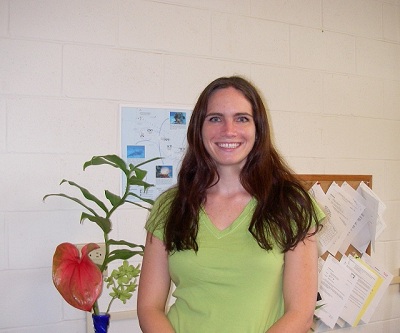
Name Amy Eggers
- Education B.S., Biology, Certified as a Technologist of Molecular Biology by the American Society for Clinical Pathology, MB (ASCP)
- Target Audience High School

Gilligan's Island has gone from uncharted territory to biologists' paradise. Read more to find out what makes being a laboratory manager at the Hawaii Institute of Marine Biology on beautiful Coconut Island in Kaneohe Bay, Oahu such a cool job!
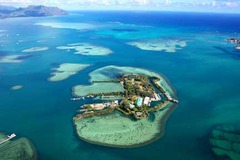 I am the manager of the Evolutionary Genetics Core Facility at the Hawaii Institute of Marine Biology (HIMB), located on the beautiful Coconut Island in Kaneohe Bay, Oahu. The purpose of this facility is to provide technical services and support for researchers at HIMB, the University of Hawaii system, as well as other institutions worldwide (such as NOAA and the USDA). The scientific instruments and equipment contained at the Core facility are available for general use of researchers, and includes: a Microarray to measure gene expression levels, a Spectrophotometer to measure DNA, RNA and proteins, and real time PCR instrument to quantify DNA. I am available on site to offer assistance with instrument protocols and troubleshooting.
I am the manager of the Evolutionary Genetics Core Facility at the Hawaii Institute of Marine Biology (HIMB), located on the beautiful Coconut Island in Kaneohe Bay, Oahu. The purpose of this facility is to provide technical services and support for researchers at HIMB, the University of Hawaii system, as well as other institutions worldwide (such as NOAA and the USDA). The scientific instruments and equipment contained at the Core facility are available for general use of researchers, and includes: a Microarray to measure gene expression levels, a Spectrophotometer to measure DNA, RNA and proteins, and real time PCR instrument to quantify DNA. I am available on site to offer assistance with instrument protocols and troubleshooting.
The facility also offers genomic services including Sanger and Illumina sequencing and fragment analysis. (DNA Sequencing determines the order of nucleotides in DNA molecule, and fragment analysis identifies DNA fragments based on size.) These services can be used for various applications such as genome sequencing, mutation detection, gene identification and expression, and genotyping.
While I work at a marine institute, I am not a marine biologist. My degree is in biology, and my work experience and expertise is in molecular biology, which is the study of biology at the molecular level.
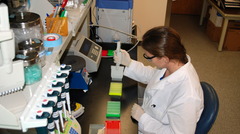 I am a lab rat. I love working in the lab, learning new protocols or experiments, troubleshooting, and discovering how and why things work.
I am a lab rat. I love working in the lab, learning new protocols or experiments, troubleshooting, and discovering how and why things work.
There isn't one! For me, every day is different. One day I could be running experiments on coral gene expression or shark and dolphin genetics for researchers, and the next I could be discussing designs for research projects, or educating researchers about the technologies used in the facility. What I do each day depends on the needs of the people using the facility.
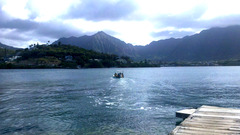 The only thing that doesn't change for me is my daily water commute. To access my lab I must go by boat, which runs from the main island of Oahu to the famous Coconut Island. Coconut Island is best known from its appearance during the opening credits of the 1960's TV show "Gilligan's Island"! I love the boat ride because I get to take in beautiful views of the Koolau mountains.
The only thing that doesn't change for me is my daily water commute. To access my lab I must go by boat, which runs from the main island of Oahu to the famous Coconut Island. Coconut Island is best known from its appearance during the opening credits of the 1960's TV show "Gilligan's Island"! I love the boat ride because I get to take in beautiful views of the Koolau mountains.
I get to contribute to many different research projects. Without the equipment, services, and support provided by my laboratory, many researchers wouldn't be able to conduct their experiments. The instrumentation and services offered by my laboratory are important tools for scientific research being conducted in Hawaii.
My favorite subject was math because I understood it and was good at it. Mathematics made more sense to me than other subjects.
There wasn't a specific moment that I knew I wanted to become a scientist, but my interest in science started early. In sixth grade I got to dissect a cow eyeball in science class. We looked at all of the components of the eyeball, and studied their individual functions. I thought it was so cool that I decided to bring the eyeball home and save it in my refrigerator. That's when I also learned that my mother is a screamer!
Throughout middle school and high school I really enjoyed math and physics classes. In college I discovered that science classes were really my favorite, and once I got my first job in a laboratory, everything really fell into place. I was able to work at my own pace in a calm, quiet setting. I also discovered I was good at precision work, and I knew at that point that I had found where I belonged.
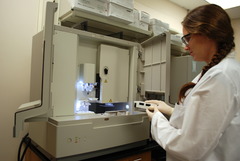 My biggest challenge was learning patience. Research can be a long process, and there are many small but important steps involved in reaching a goal. I had to learn that each step requires time, patience and accuracy. You have to work for your discoveries!
My biggest challenge was learning patience. Research can be a long process, and there are many small but important steps involved in reaching a goal. I had to learn that each step requires time, patience and accuracy. You have to work for your discoveries!
I was most inspired by my former neighbor, Tanya Vickers. Tanya taught biology at the University of Utah, and assisted me in getting my first lab job, as well as providing great encouragement and support. I am convinced that I wouldn't be where I am today without Tanya's guidance.
An example of a program that I recommend is the Pacific Center for Environmental Studies, also known as PACES. This 6 week program allows High School students in their junior or senior year to learn about environmental science in the classroom, in the field and in the laboratory. Students even get to develop their own research projects and present their results at a symposium! Look to see if there are programs like this in your community.
High school students can also get a part time or summer job as a laboratory technician in order to gain hands-on experience in the science field.
I recommend specializing in biology, molecular biology or molecular genetics. Talk to your high school counselor for more information on related courses that may be offered in your school, as well as competitive college programs in your area.
For the first 3 years that I worked at HIMB, they solely offered Sanger sequencing and fragment analysis services. When HIMB first acquired an Illumina next generation sequencer, we were able to generate more sequencing data in 2 weeks than we had in the previous three years combined!
The cost to analyze and manage sequencing data is now greater than the cost to generate it. Scientists are overwhelmed with the amount of data that is generated, and new techniques are constantly being developed to analyze this data in the field of bioinformatics. This will be a key field in the future of science.
Bioinformatics: the retrieval and analysis of biochemical and biological data using mathematics and computer science, as in the study of genomes.
Gene Expression: Gene expression is the process of taking information from a gene into messenger RNA, and then to a protein.
Genome: Every organism has a genome. It is the material required to create a full set of chromosomes; all the inheritable traits of an organism.
NOAA: National Oceanic and Atmospheric Administration
USDA: United States Department of Agriculture
Mariana Fuentes always loved working with animals, but she didn't know …
Do you like fish, going on cruises, or getting your favorite clothes at…
Ever wondered what those people who take care of animals in the aquariu…